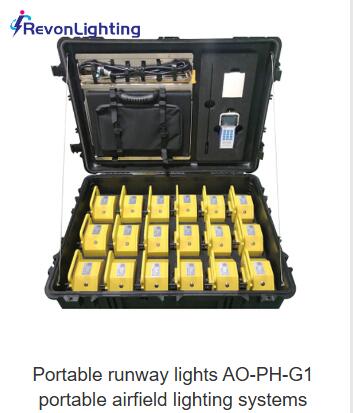Portable airfield lighting systems and portable helipad solutions are crucial in aviation, providing essential support for various temporary and emergency scenarios. These systems ensure the safety and efficiency of air operations in locations lacking permanent infrastructure or where existing facilities are unavailable.
Applications
Portable airfield lighting systems are used in diverse situations, from military operations and disaster relief to remote construction projects and special events. These systems enable the rapid establishment of temporary airfields, ensuring that aircraft can safely take off and land in areas without permanent lighting infrastructure. For military operations, portable airfield lighting systems offer strategic advantages, allowing for quick deployment in diverse and often hostile environments. In disaster relief, these systems are vital for setting up emergency airstrips, facilitating the swift delivery of aid and evacuation of personnel.

Similarly, portable helipad solutions are essential for enabling helicopter operations in various contexts, including medical emergencies, search and rescue missions, and remote site access. These portable helipads provide a stable and safe landing area, ensuring that helicopters can operate efficiently even in challenging environments.
Technology and Features
Modern portable airfield lighting systems and portable helipad solutions incorporate advanced technologies to enhance performance and reliability. Many lighting systems use energy-efficient LED lights, which offer superior brightness and durability. These systems often feature wireless control options, enabling operators to adjust lighting settings remotely. Solar-powered options are also available, providing an environmentally friendly solution that reduces the need for external power sources.
| Portable Airfield Lighting Systems | ER |
| TLOF | RT |
Portable helipad solutions are designed for quick deployment and easy transportation. They typically include modular components that can be assembled and disassembled rapidly. These helipads are constructed from durable materials, ensuring they can withstand various environmental conditions and heavy use.
Deployment and Maintenance
The deployment of portable airfield lighting systems and portable helipad solutions is straightforward, requiring minimal training and equipment. These systems are designed for rapid setup, often featuring intuitive interfaces and modular components. Maintenance is generally low, with many systems built to withstand harsh conditions and frequent use. Regular inspections and basic upkeep are usually sufficient to ensure optimal performance.
Safety and Regulation
Safety is a top priority in aviation, and portable airfield lighting systems and portable helipad solutions must meet stringent standards to ensure reliability and effectiveness. Regulatory bodies, such as the Federal Aviation Administration (FAA) and the International Civil Aviation Organization (ICAO), provide guidelines and certifications for these systems. Compliance with these regulations ensures that the lighting systems and helipads are safe for use in various operational contexts and meet the necessary performance criteria.
Future Trends
The future of portable airfield lighting systems and portable helipad solutions will likely see continued advancements in technology and design. Innovations such as improved battery life, enhanced wireless connectivity, and more robust construction materials will further increase the reliability and convenience of these systems. Additionally, the integration of smart technologies, such as automated lighting adjustments based on environmental conditions, will enhance operational efficiency and safety.
Portable airfield lighting systems and portable helipad solutions play a crucial role in maintaining the safety and functionality of air operations in temporary or emergency situations. Their flexibility, ease of deployment, and advanced features make them invaluable tools for military, disaster relief, and remote construction applications. As technology continues to evolve, these systems will only become more efficient and reliable, ensuring that air operations can proceed smoothly, regardless of the circumstances.